Pannonia was a province of the Roman Empire.
Contents
Pannonia or Pannonian may also refer to:
Pannonia was a province of the Roman Empire.
Pannonia or Pannonian may also refer to:

Pannonia was a province of the Roman Empire bounded on the north and east by the Danube, coterminous westward with Noricum and upper Italy, and southward with Dalmatia and upper Moesia. Pannonia was located in the territory that is now western Hungary, western Slovakia, eastern Austria, northern Croatia, north-western Serbia, northern Slovenia, and northern Bosnia and Herzegovina.
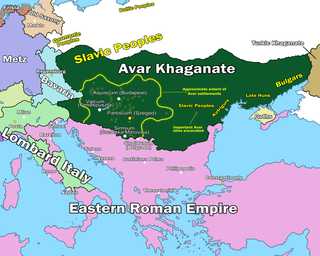
The Pannonian Avars were an alliance of several groups of Eurasian nomads of various origins. The peoples were also known as the Obri in chronicles of Rus, the Abaroi or Varchonitai, or Pseudo-Avars in Byzantine sources, and the Apar to the Göktürks. They established the Avar Khaganate, which spanned the Pannonian Basin and considerable areas of Central and Eastern Europe from the late 6th to the early 9th century.

Sirmium was a city in the Roman province of Pannonia, located on the Sava river, on the site of modern Sremska Mitrovica in the Vojvodina autonomous province of Serbia. First mentioned in the 4th century BC and originally inhabited by Illyrians and Celts, it was conquered by the Romans in the 1st century BC and subsequently became the capital of the Roman province of Pannonia Inferior. In 294 AD, Sirmium was proclaimed one of four capitals of the Roman Empire. It was also the capital of the Praetorian prefecture of Illyricum and of Pannonia Secunda. The site is protected as an archaeological Site of Exceptional Importance. The modern region of Syrmia was named after the city.

Mačva is a geographical and historical region in the northwest of Central Serbia, on a fertile plain between the Sava and Drina rivers. The chief town is Šabac. The modern Mačva District of Serbia is named after the region, although the region of Mačva includes only the northern part of this district. A small northern part of Mačva region is in the Autonomous Province of Vojvodina, in the Syrmia District.
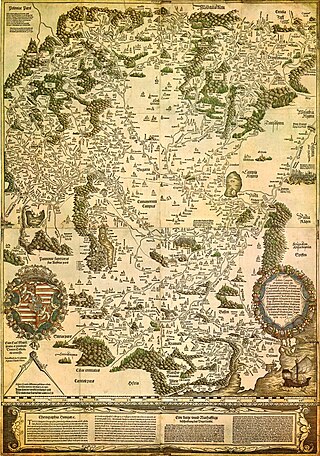
The history of Hungarybefore the Hungarian conquest spans the time period before the Hungarian conquest in the 9th century of the territories that would become the Principality of Hungary and the Kingdom of Hungary.

Tomislav was the first king of Croatia. He became Duke of Croatia c. 910 and was crowned king in 925, reigning until 928. During Tomislav's rule, Croatia forged an alliance with the Byzantine Empire against Bulgaria. Croatia's struggles with the First Bulgarian Empire eventually led to war, which culminated in the decisive Battle of the Bosnian Highlands in 926. In the north, Croatia often clashed with the Principality of Hungary; the state retained its borders and, to some extent, expanded with the disintegrated Lower Pannonia.

The Pannonian Basin, or Carpathian Basin, is a large sedimentary basin situated in southeast Central Europe. After the WW1 and Treaty of Trianon, the geomorphological term Pannonian Plain became more widely used for roughly the same region though with a somewhat different sense, with only the lowlands, the plain that remained when the Pliocene Epoch Pannonian Sea dried out.
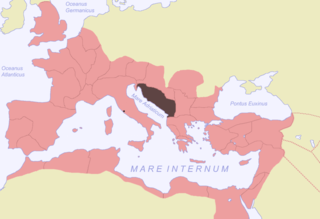
Illyricum was a Roman province that existed from 27 BC to sometime during the reign of Vespasian. The province comprised Illyria/Dalmatia in the south and Pannonia in the north. Illyria included the area along the east coast of the Adriatic Sea and its inland mountains, eventually being named Dalmatia. Pannonia included the northern plains that now are a part of Serbia, Croatia and Hungary. The area roughly corresponded to part or all of the territories of today's Albania, Kosovo, Montenegro, Serbia, Bosnia and Herzegovina, Croatia, and Slovenia.

Transdanubia is a traditional region of Hungary. It is also referred to as Hungarian Pannonia, or Pannonian Hungary.
Vojvodina is an autonomous province located in northern Serbia. It consists of the Pannonian Plain in the south, and the Danube and Sava rivers in the north.
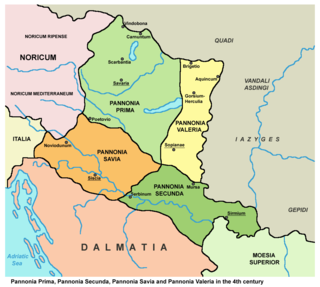
The Pannonia Valeria or simply Valeria, also known as Pannonia Ripensis, was one of the provinces of the Roman Empire. It was formed in the year 296, during the reign of emperor Diocletian, in a division of Pannonia Inferior. The capital of the province was Sopianae. Pannonia Valeria included parts of present-day Hungary and Croatia.
Raška may refer to:
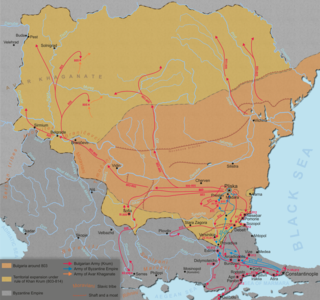
The Timočani were a medieval South Slavic tribe that lived in the territory of present-day eastern Serbia, west of the Timok River, as well as in the regions of Banat, Syrmia and Moesia Superior.

Early Slavs settled in the eastern and southern parts of the former Roman province of Pannonia. The term Lower Pannonia was used to designate those areas of the Pannonian plain that lie to the east and south of the river Rába, with the division into Upper and Lower inherited from the Roman terminology.
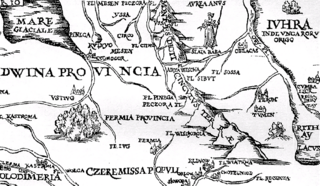
Hungary, the name in English for the European country, is an exonym derived from the Medieval Latin Hungaria. The Latin name itself derives from the ethnonyms (H)ungarī, Ungrī, and Ugrī for the steppe people that conquered the land today known as Hungary in the 9th and 10th centuries. Medieval authors denominated the Hungarians as Hungaria, but the Hungarians even contemporarily denominate themselves Magyars and their homeland Magyarország.

Posavina is a geographical region that stretches along the Sava river, encompassing only the inner areas of the Sava river basin, that are adjacent or near to the Sava river itself, namely catch region spanning from the Julian Alps in the northwest to the confluence with the Danube in the southeast. It passes through several countries of former Yugoslavia, namely Slovenia, Croatia, Bosnia and Herzegovina and Serbia. In Slovene, the term Posavina is not used to describe the parts of Slovenia that lie by the Sava river. Instead, the terms Posavje, Zasavje and Zgornjesavska dolina are used.
The Battle of Drava River was fought between the army of Tomislav of Croatia and the forces of Hungarian tribes led by Grand Prince Zoltán, the youngest son of Árpád, founder of the Árpád dynasty.
Southern Pannonia may refer to:
Northern Pannonia may refer to: